During the first volume of Love and Rockets, Hopey undergoes several fashion transformations. Let's take a look at that glorious punk tornado, La Hopita. Keep your arms and hands inside the car at all times.
Since Jaime Hernandez makes frequent use of flashbacks, in order to get the fullest understanding of Hopey's many transformations, we have to start near the end of the first volume, in the "Wigwam Bam" storyline. Here Jaime's leads Hopey and Maggie separate after an argument. Indeed, Jaime cuts Maggie out of the narrative completely, focusing instead of Hopey's misadventures in an East Coast city where she falls in with a former TV star who is now an aged, prune-faced perv engaging in some kind of club for other aged, prune-faced pervs where they dress prostitutes as little girls and engage in who knows what.
And it's during this story that Jaime gives us a glimpse of child Hopey:

Biographical details such as these give some much-needed vulnerability to the otherwise seemingly invincible Hopey. It also supplements an even earlier flashback from the "Jerusalem Crickets"/"Flies on the Ceiling" period, in a brilliant little story that focuses on Hopey's mentor and discarded lover Terry Downe, "Tear It Up, Terry Downe." Here, Jaime presents a pre-punk Hopey as an introverted teen, terrified of the new girl in class who would soon change her life irrevocably:
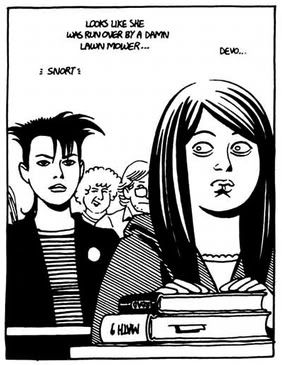 Generally, throughout the narrative, Hopey's motivations are either somewhat obscure (what causes her to womanize and generally keep love at arm's length) or else patently transparent (she cannot stop hitting on women in the most blatant of fashions). Consequently, she often comes across as person almost without inhibitions. Here Jaime hints at Hopey's inner complexity and discovers the wounded psyche that births the independent and charismatic persona she adopts. Because by the end of that story, Hopey (under Terry's tutelage) has fully metamorphosed into a raging hardcore punk with a shaved head. It's around this time that she first meets Maggie. This initial encounter-- engineered by Maggie's friend Izzy-- evidently does not go as planned:
Generally, throughout the narrative, Hopey's motivations are either somewhat obscure (what causes her to womanize and generally keep love at arm's length) or else patently transparent (she cannot stop hitting on women in the most blatant of fashions). Consequently, she often comes across as person almost without inhibitions. Here Jaime hints at Hopey's inner complexity and discovers the wounded psyche that births the independent and charismatic persona she adopts. Because by the end of that story, Hopey (under Terry's tutelage) has fully metamorphosed into a raging hardcore punk with a shaved head. It's around this time that she first meets Maggie. This initial encounter-- engineered by Maggie's friend Izzy-- evidently does not go as planned: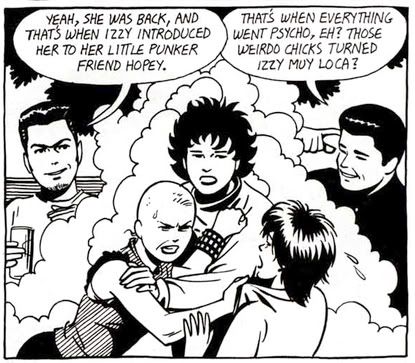 But it proves a momentous event. Jaime revisits this Hopey a few more times, including once in volume two.
But it proves a momentous event. Jaime revisits this Hopey a few more times, including once in volume two.Now we come to what I think of as "Classic Hopey." This is how Hopey first appears on the pages of Love and Rockets:
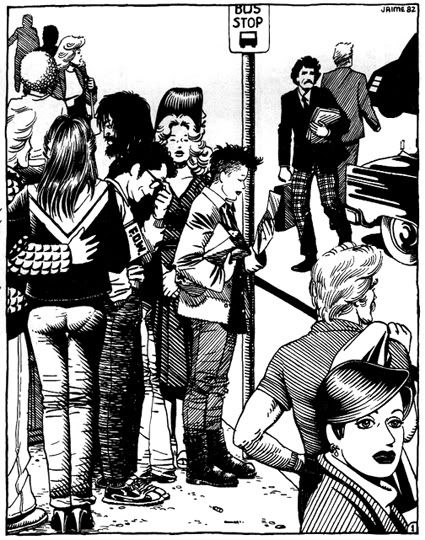 She sports a spiky boy's haircut and lots of androgynous punk gear. Jaime's art style-- while certainly very pretty-- is a bit unformed here, but Hopey herself is already in full-swing as she makes comic book history. Jaime's artwork becomes slicker and more controlled over time, but Hopey maintains this basic look throughout the middle period Love and Rockets and through several pivotal storylines, albeit with some minor variations.
She sports a spiky boy's haircut and lots of androgynous punk gear. Jaime's art style-- while certainly very pretty-- is a bit unformed here, but Hopey herself is already in full-swing as she makes comic book history. Jaime's artwork becomes slicker and more controlled over time, but Hopey maintains this basic look throughout the middle period Love and Rockets and through several pivotal storylines, albeit with some minor variations.Here's one: bleached blonde Hopey wearing what appears to be secondhand clothes of a more traditionally feminine mode. A head scarf like a Hitchcock film heroine, what looks like someone's old letter sweater, various belts as accessories, a calf-length pleated skirt and some torn tights:
Blonde Hopey breaking the "fourth wall" to get even with fangirl Maggie:
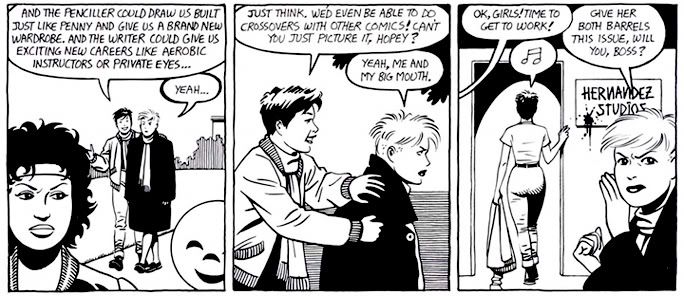 This is the basic hairstyle Hopey wears during her infamous grafitti battles against Officer Sado, her arch-nemesis. One of my favorite aspects of Hopey's style during this period is the way Jaime shows her willing to actively challenge the gender dichotomy of "straight" society. While Maggie occasionally derides her as a "boy-looking peesashit," Hopey seems to delight in otherwise challenging gender expectations, as when she pairs her butch haircut with a very feminine 1950's style sundress, complete with bow detail. She has a kind of Jane Wiedlin/Go-Go's look going on here:
This is the basic hairstyle Hopey wears during her infamous grafitti battles against Officer Sado, her arch-nemesis. One of my favorite aspects of Hopey's style during this period is the way Jaime shows her willing to actively challenge the gender dichotomy of "straight" society. While Maggie occasionally derides her as a "boy-looking peesashit," Hopey seems to delight in otherwise challenging gender expectations, as when she pairs her butch haircut with a very feminine 1950's style sundress, complete with bow detail. She has a kind of Jane Wiedlin/Go-Go's look going on here: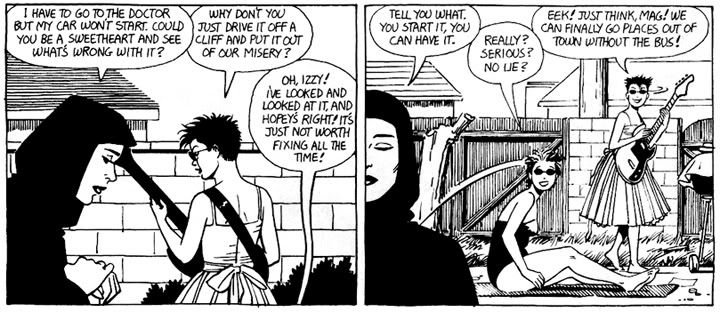 I can't help but picture the dress as pale pink. Of course, she sports a very phallic prop, her bass guitar. With Hopey, femininity comes with an edgy quality. This is also expressed via Hopey's fearless sexuality and erotic adventurism. Here she's practically falling out of an unbuttoned shirt-dress, adopting an aggressively open posture and it seems she couldn't care less:
I can't help but picture the dress as pale pink. Of course, she sports a very phallic prop, her bass guitar. With Hopey, femininity comes with an edgy quality. This is also expressed via Hopey's fearless sexuality and erotic adventurism. Here she's practically falling out of an unbuttoned shirt-dress, adopting an aggressively open posture and it seems she couldn't care less: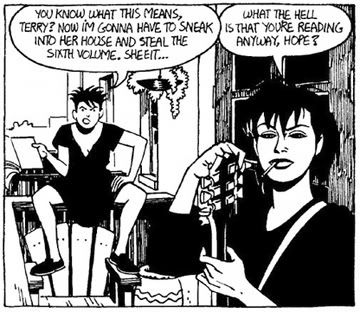 I tend to assume Terry's nonchalance here is a bit of a put-on. But why shouldn't Hopey flaunt it a little? Jaime often makes Hopey the fought-over object of desire by any number of would-be lovers, and gives Hopey a full awareness of her physical and emotional impact on others. In fact, she seems to delight in it and frequently takes advantage, as shown in the "Wigwam Bam" sequence where she plays various people against each other in order to secure places to crash for days or weeks at a time.
I tend to assume Terry's nonchalance here is a bit of a put-on. But why shouldn't Hopey flaunt it a little? Jaime often makes Hopey the fought-over object of desire by any number of would-be lovers, and gives Hopey a full awareness of her physical and emotional impact on others. In fact, she seems to delight in it and frequently takes advantage, as shown in the "Wigwam Bam" sequence where she plays various people against each other in order to secure places to crash for days or weeks at a time.Here's an interesting look at Classic Hopey in a more boyish punk state. This is from the bizarre fantasy "Easter Hunt," (based on a story Jaime's brother Gilberto wrote as a child) where Maggie and Hopey revert to earlier visual states in order to eat Easter eggs, fly around in a UFO and murder Julie Wree. She's wearing a torn DOA tee and pegged punk pants probably in black denim, although Jaime doesn't add any surface detail and instead opts for a bold all-black silhouette. Earlier in the story, she's barefoot, but in these panels is foot-clad in black high top Chuck Taylors:
 Quite androgynous. Note her unbuttoned fly and visible underwear. And here's Classic Hopey in her long, black pea- or trenchcoat. Full-on punk tomboy mode:
Quite androgynous. Note her unbuttoned fly and visible underwear. And here's Classic Hopey in her long, black pea- or trenchcoat. Full-on punk tomboy mode: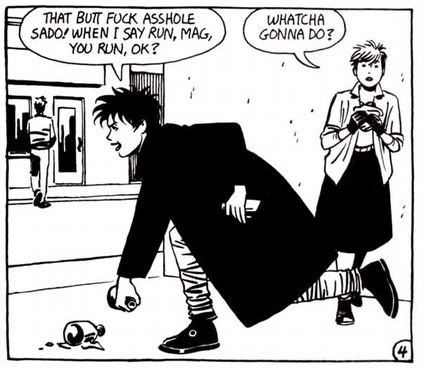 Planning payback against Officer Sado. Oh, Hopey, will you never learn? Those are some fierce looking buckled shoes/boots. No doubt Jaime could tell us the exact make. This follows a charming sequence in which Hopey gets her haircut in that most masculine of style-environs, the old school barber shop. She emerges with a slicked up boy-cut that she musses into spikes.
Planning payback against Officer Sado. Oh, Hopey, will you never learn? Those are some fierce looking buckled shoes/boots. No doubt Jaime could tell us the exact make. This follows a charming sequence in which Hopey gets her haircut in that most masculine of style-environs, the old school barber shop. She emerges with a slicked up boy-cut that she musses into spikes.Hopey sports this look consistently thoughout the "Jerusalem Cricket" stories in which she embarks on an ill-fated cross country tour with the punk band La Llorona. It's here that Jaime begins to depart from the series' status quo. He also embarks on more extended and complex narratives. Here it appears she's wearing a peacoat:
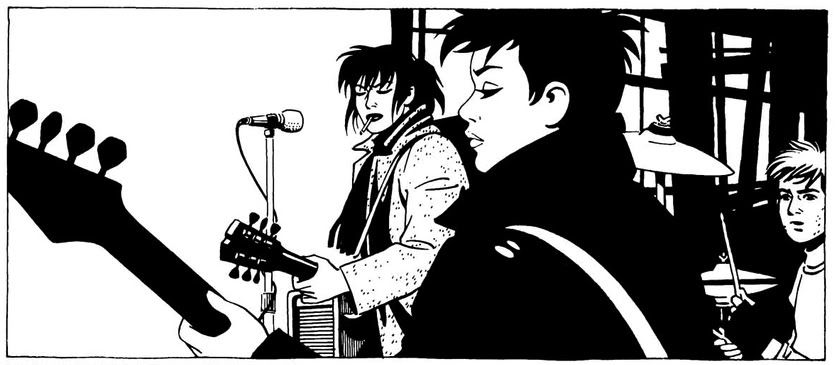 That's a gorgeous panel by Jaime. He has always had a reporter's eye for detail and a masterful way of reducing an image to essentials. Your mind fills in a lot of what Jaime has deliberately left out of the drawing. From the drummer's expression, I'd imagine Hopey has once again managed to fuck up the bass line.
That's a gorgeous panel by Jaime. He has always had a reporter's eye for detail and a masterful way of reducing an image to essentials. Your mind fills in a lot of what Jaime has deliberately left out of the drawing. From the drummer's expression, I'd imagine Hopey has once again managed to fuck up the bass line.While the characters undergo emotional development and changes, Jaime echoes this with visual changes. Maggie rapidly gains weight, becoming more curvaceous. And Jaime realistically depicts the effects of touring on Hopey, in various seedy venues and run-down motels, as her clothes grow shabbier and her hair longer. Jaime teases the readers by keeping Maggie and Hopey apart for hundreds of pages and various misadventures. Eventually, Hopey is gone from Hoppers and the narrative for so long, she becomes almost legendary. Here, Maggie speculates on Hopey's appearance:
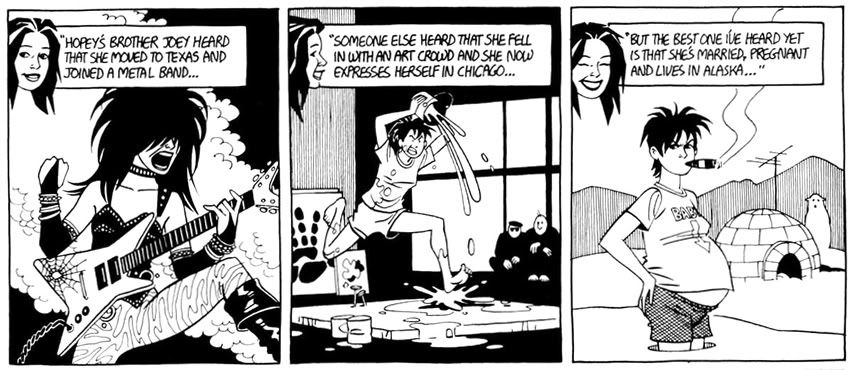 What Maggie has no way of knowing at this point is that Hopey now looks like this:
What Maggie has no way of knowing at this point is that Hopey now looks like this: They meet in a police station and react to the physical transformations each has undergone:
They meet in a police station and react to the physical transformations each has undergone: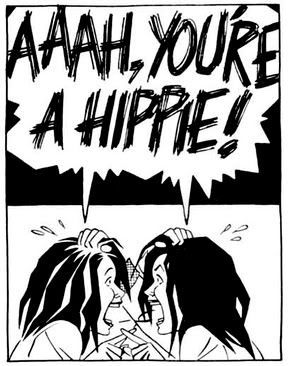 But Jaime does not allow the two to enjoy their reunion for long. He almost immediately puts them into conflict with each other and now it's Maggie who vanishes from the narrative, leaving a changed Hopey adrift in a world of perversity and violence. This, then, is "Wigwam Bam," the penultimate storyline of volume one. In it, Hopey emerges briefly as the central character, and sports a wild plume of cropped hair. I call this look "Crazy Hair Hopey," and it's actually one of my favorites. I love the little shout outs to bands from Jaime via Hopey's tee's:
But Jaime does not allow the two to enjoy their reunion for long. He almost immediately puts them into conflict with each other and now it's Maggie who vanishes from the narrative, leaving a changed Hopey adrift in a world of perversity and violence. This, then, is "Wigwam Bam," the penultimate storyline of volume one. In it, Hopey emerges briefly as the central character, and sports a wild plume of cropped hair. I call this look "Crazy Hair Hopey," and it's actually one of my favorites. I love the little shout outs to bands from Jaime via Hopey's tee's: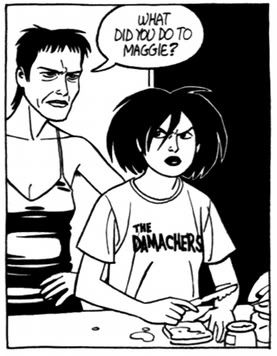 The Damachers are a fictional band in which Hopey eventually plays bass following the demise of La Llarona and at least one other band she's fired from. But this next band is quite real:
The Damachers are a fictional band in which Hopey eventually plays bass following the demise of La Llarona and at least one other band she's fired from. But this next band is quite real: After concluding "Wigwam Bam," Jaime returns Maggie to her familiar role as central protagonist and embarks on the emotional "Chester Square" storyline to conclude Love and Rockets volume one. Here we find a more girly-girl Hopey still playing bass for the Damachers, but constantly distracted by Maggie-centric daydreams. She sports a very feminine hairstyle and look here, kind of like a compact Audrey Hepburn (who Jaime would later reference more overtly when Penny Century styles Hopey's hair into a kind of neo-Holly Golightly 'do):
After concluding "Wigwam Bam," Jaime returns Maggie to her familiar role as central protagonist and embarks on the emotional "Chester Square" storyline to conclude Love and Rockets volume one. Here we find a more girly-girl Hopey still playing bass for the Damachers, but constantly distracted by Maggie-centric daydreams. She sports a very feminine hairstyle and look here, kind of like a compact Audrey Hepburn (who Jaime would later reference more overtly when Penny Century styles Hopey's hair into a kind of neo-Holly Golightly 'do):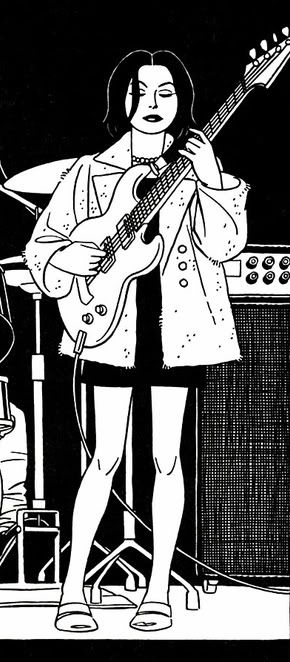 A stylish a-line cloth (tweed? wool?) coat hints at a more sophisticated Hopey. But if you look closer, you see the material is frayed and worn; Hopey is still a punk at heart, and still living fast. Her thin, bare legs give her a fragile quality that seems at odds with her edgy personality. This is Jaime giving us visually the characterization a lesser creator would have to do with prose narration or dialogue.
A stylish a-line cloth (tweed? wool?) coat hints at a more sophisticated Hopey. But if you look closer, you see the material is frayed and worn; Hopey is still a punk at heart, and still living fast. Her thin, bare legs give her a fragile quality that seems at odds with her edgy personality. This is Jaime giving us visually the characterization a lesser creator would have to do with prose narration or dialogue. And with that final Hopey style transformation, Jaime brings Love and Rockets volume one to a close. Still, I wonder what hardcore punk Hopey would say if she knew she exists merely as a fictional character whose various clothing choices not only reflect her growth as a person, but also entertain us as readers:

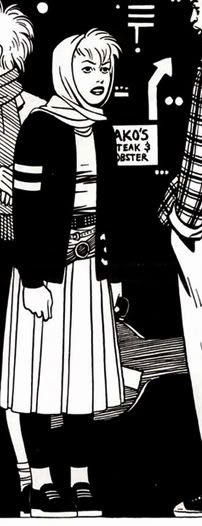

4 comments:
Great observations!
Thanks! There are few things and literally no comics I love as much as Love and Rockets!
This was awesome. Entirely by accident, my hairstyle has seemed to evolve along with the fashion I don't really think about or-pre plan along the same path as Hopey. When I met my best friend 20+ years ago, he started to call me Hopey because of my hairstyle. I was then introduced to the Love and Rockets series, and it was almost creepy if I missed a few years how Hopey was still looking like me, or I like her, as we aged. Being on tour musically DOES leave you tattered. Great attention to detail I never realized before.
Many thanks, Pepper! One amazing thing about Love and Rockets is Jaime is such a great observer of humanity, you can recognize yourself or people you know in the characters. Sometimes I see little pieces of my own life experiences in the stories, seedy punk rock things we used to do. Hopey is everything I wish I was!
Post a Comment